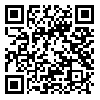Volume 15, Issue 4 (oct & Nov 2021)
payavard 2021, 15(4): 353-364 |
Back to browse issues page
Download citation:
BibTeX | RIS | EndNote | Medlars | ProCite | Reference Manager | RefWorks
Send citation to:



BibTeX | RIS | EndNote | Medlars | ProCite | Reference Manager | RefWorks
Send citation to:
Dalili Saleh M, Salami M, Soheili F, Ziaei S. The Attitude of Library Users at Universities of Medical Sciences towards Augmented Reality Technology. payavard 2021; 15 (4) :353-364
URL: http://payavard.tums.ac.ir/article-1-7148-en.html
URL: http://payavard.tums.ac.ir/article-1-7148-en.html
1- Ph.D. in Knowledge and Information Science, Varamin Health Higher Education Complex, Shahid Beheshti University of Medical Sciences, Tehran, Iran , Dalilim@sbmu.ac.ir
2- Assistant Professor, Department of Knowledge and Information Science, Payam e Noor University, Tehran, Iran
3- Associate Professor, Department of Knowledge and Information Science, Payam e Noor University, Tehran, Iran
2- Assistant Professor, Department of Knowledge and Information Science, Payam e Noor University, Tehran, Iran
3- Associate Professor, Department of Knowledge and Information Science, Payam e Noor University, Tehran, Iran
Abstract: (1347 Views)
Background and Aim: University libraries must meet certain criteria to enter fourth-generation libraries, one of which is the use of new technologies. The aim of this study was to identify the attitudes of library users of medical universities towards the components of augmented reality (AR) technology.
Materials and Methods: The research method was survey and type of study was applied. Quantitative research approach and research tool was a researcher-made questionnaire. The internal validity of the questionnaire was assessed through CVI and its reliability was estimated using ICC. Validity of the questionnaire was confirmed using the opinions of 10 experts in information science and AR; its reliability was obtained with Cronbach’s alpha correlation coefficient (0.96). Through the online questionnaire, data from users’ perspectives on the components of familiarity, features, application, advantages, opportunities and limitations were collected in the form of 5 Likert questions. Data analysis with SPSS 26 was used through independent t-test, ANOVA and Tukey to evaluate the status of AR components.
Results: Users’ familiarity with AR was 50.55%. 78.23% of the users agreed with AR in the libraries of medical universities. In general, the mean was 3.91 and the standard deviation was 0.63. The possibility of developing research activities, use of technology to enhance learning, advantage of attractiveness, and opportunity to develop a scientific educational program were mentioned as the most important items among other AR factors. One of the limitations of setting it up in university libraries was the lack of high-speed internet. The general attitude of users towards AR was at the desired level.
Conclusion: Library users at medical universities agreed with the facilities, opportunities and use of AR. The results showed that AR technology is practical and useful from the perspective of users in the libraries of Iranian medical universities. AR with user support, improving user activity, creating attractiveness, attracting audience, content creation according to various library resources, content gamification, knowledge sharing, content resource deprivation, based on the availability of technical facilities, an opportunity to develop Creates libraries of medical universities.
Materials and Methods: The research method was survey and type of study was applied. Quantitative research approach and research tool was a researcher-made questionnaire. The internal validity of the questionnaire was assessed through CVI and its reliability was estimated using ICC. Validity of the questionnaire was confirmed using the opinions of 10 experts in information science and AR; its reliability was obtained with Cronbach’s alpha correlation coefficient (0.96). Through the online questionnaire, data from users’ perspectives on the components of familiarity, features, application, advantages, opportunities and limitations were collected in the form of 5 Likert questions. Data analysis with SPSS 26 was used through independent t-test, ANOVA and Tukey to evaluate the status of AR components.
Results: Users’ familiarity with AR was 50.55%. 78.23% of the users agreed with AR in the libraries of medical universities. In general, the mean was 3.91 and the standard deviation was 0.63. The possibility of developing research activities, use of technology to enhance learning, advantage of attractiveness, and opportunity to develop a scientific educational program were mentioned as the most important items among other AR factors. One of the limitations of setting it up in university libraries was the lack of high-speed internet. The general attitude of users towards AR was at the desired level.
Conclusion: Library users at medical universities agreed with the facilities, opportunities and use of AR. The results showed that AR technology is practical and useful from the perspective of users in the libraries of Iranian medical universities. AR with user support, improving user activity, creating attractiveness, attracting audience, content creation according to various library resources, content gamification, knowledge sharing, content resource deprivation, based on the availability of technical facilities, an opportunity to develop Creates libraries of medical universities.
Send email to the article author
| Rights and permissions | |
 |
This work is licensed under a Creative Commons Attribution-NonCommercial 4.0 International License. |





